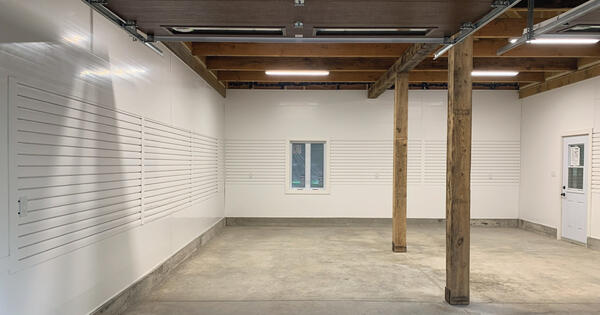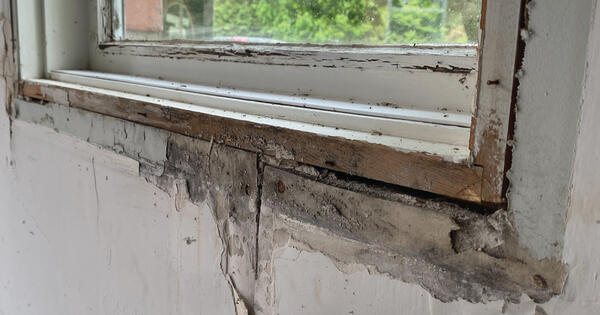Drywall has long been the go-to material for interior walls and ceilings. It’s affordable, relatively easy to install, and widely available, which is why it shows up in almost every new build and renovation project across North America. But just because drywall is common doesn’t mean it’s always the best choice for your space.
Depending on where you plan to use it and how your home functions day to day, drywall might come with some serious drawbacks that can impact both your budget and your long-term satisfaction. If you’re starting a renovation or building project, it’s worth taking a closer look at whether drywall will truly hold up to your space and lifestyle — or if it’s time to consider an alternative.Top Drywall Disadvantages
Before committing to drywall, it’s important to understand the ways it can fall short. These disadvantages are common pain points for homeowners — and depending on the space, they could influence whether drywall is the right material for your next project.
Drywall Disadvantage #1: Drywall Is Susceptible to Moisture and Mold
Drywall doesn’t mix well with moisture. It’s made with a paper facing and a gypsum core — both of which readily absorb water. That makes it a risky material choice in areas that are damp, humid, or prone to water leaks or condensation buildup.
When drywall gets wet, several problems can occur — often with lasting consequences:
- Warping and deterioration: Moisture causes drywall to swell, soften, and lose its shape. Over time, the panels may crumble or collapse entirely.
- Mold growth: The paper surface of drywall provides an organic food source for mold and mildew. In the right conditions, mold can develop within 24 to 48 hours of exposure to moisture and quickly spread behind walls or ceilings.
- Hidden damage: Not all water damage is visible. Small leaks behind walls, rising humidity, or even condensation can quietly compromise drywall, leading to serious issues that aren’t discovered until repairs become unavoidable.
For spaces like bathrooms, basements, laundry rooms, or any area that experiences frequent moisture or high humidity, traditional drywall isn’t the most reliable option. Even moisture-resistant drywall products — sometimes marketed as “green board” or “purple board” — can fail if they’re exposed to standing water, improper ventilation, or installation errors.
Drywall Disadvantage #2: It’s Not Impact Resistant
In high-traffic areas, drywall tends to show its weaknesses pretty quickly. Whether it’s a doorknob bumping into the wall, a piece of furniture scraping past, or kids playing a little too roughly, drywall is prone to physical damage from everyday activities.
Here are some of the most common issues you’ll run into when it comes to drywall durability:
- Easy to dent or puncture: A light bump from a chair or vacuum can leave noticeable dents, scratches, or even holes.
- Cracks from everyday stress: Drywall is rigid, so as a home naturally shifts or settles, it can crack along seams, especially around doors, windows, and corners.
- Frequent repairs in busy households: Homes with kids, pets, or lots of daily movement often require routine patching, sanding, and repainting to keep walls looking smooth and clean.
If you're planning a renovation in a hallway, mudroom, playroom, or garage entry — or anywhere that sees a lot of action — drywall might not hold up as well as you'd like. Constant wear and tear can quickly lead to a frustrating cycle of cosmetic fixes and touch-ups.

Drywall Disadvantage #3: Installation Is Messy and Time-Consuming
While drywall may seem straightforward, the installation process is anything but quick and clean. It involves multiple steps — cutting sheets to size, lifting and fastening them to studs, applying joint tape and compound, sanding smooth, then repeating that process as needed. And that’s all before you even get to the priming and painting stage.
Here’s what you can expect when drywall installation is underway:
- Dust and debris: Sanding drywall compound creates a fine, talc-like dust that spreads everywhere — including HVAC vents, baseboards, flooring, and furniture — and can be tough to fully clean.
- Noise and disruption: Cutting panels, using screw guns, and sanding can create a significant amount of noise, especially when the job stretches over multiple days.
- Delays between steps: Drying times between mudding and sanding stages often mean you have to wait hours (or even overnight) before you can move on to the next step, dragging out timelines.
If you’re renovating a lived-in space — especially while still occupying the home — drywall installation can create more mess and disruption than you might anticipate. It’s rarely a “quick fix” and usually comes with a fair bit of inconvenience.
Drywall Disadvantage #4: Finishing and Painting Require Ongoing Maintenance
Drywall rarely stays looking flawless for long — especially in busy or moisture-prone environments. Once installed, the panels need to be primed and painted, and from there, homeowners are usually on the hook for regular upkeep.
Drywall surfaces are prone to a range of common issues over time:
- Visible imperfections: Cracks from settling, popped nails or screws, and poor taping can show through paint and worsen over time.
- Frequent touch-ups: Everyday life takes its toll. Whether it’s a scratch from a chair, a dent from a toy, or a stain from a spilled drink, drywall frequently needs sanding, patching, and repainting to maintain a clean appearance.
- Paint wear: In high-traffic areas, paint can fade, peel, or collect dirt quickly — and painted drywall doesn’t always hold up well to scrubbing, making it harder to clean without damaging the surface.
Keeping drywall looking good takes consistent effort, and in many homes, that means budgeting for repainting every few years. If you’re after a more durable, low-maintenance wall finish, drywall may not be the ideal solution.
Drywall Disadvantage #5: Not Ideal for All Rooms or Environments
Drywall works fine in dry, low-traffic areas — like bedrooms or home offices — but it struggles in spaces that are humid, messy, or used for utility. Places like laundry rooms, garages, mudrooms, and mechanical rooms often demand more durability, moisture resistance, and cleanability than drywall can offer.
Here are a few reasons drywall may not be the right material in these environments:
- Poor moisture resistance: Even specialty drywall designed for moisture-prone areas can absorb water over time, especially in rooms without proper ventilation.
- Difficult to clean: Painted drywall is not particularly washable. Dirt, mud, or oil can absorb into the surface and leave behind stains or marks that are tough to remove.
- Prone to damage: These types of spaces often involve tools, storage bins, equipment, or entry from outside — all of which increase the risk of dents, scuffs, and other damage.
If you’re planning to renovate or build out these hardworking spaces, it’s worth considering wall and ceiling materials specifically engineered for resilience and low maintenance.
Drywall Disadvantage #6: Hidden Costs Add Up Over Time
Drywall is often seen as a cost-effective option, but the long-term picture can look quite different. While it may be cheaper upfront than many alternatives, the ongoing costs tied to maintenance, repairs, and eventual replacements can add up fast, especially in areas where drywall performs poorly.
Here are some of the hidden or unexpected costs that homeowners may face:
- Ongoing repairs: Drywall damage often requires more than just a quick patch. If you're aiming for a seamless repair, you'll likely need a pro to blend and finish the surface properly.
- Frequent repainting: The cost of paint, primer, brushes, and labor — whether DIY or professional — can become a recurring expense in high-use spaces.
- Mold remediation: If drywall is exposed to prolonged moisture, mold can develop inside the wall cavity. In these cases, professional removal and remediation are required, which can be both disruptive and expensive.
- Material waste: Drywall sheets can crumble or crack during transport, cutting, or installation, leading to added waste and increased material costs.
When you factor in these long-term issues, drywall may not be as economical as it first appears, especially when compared to materials that offer longer-lasting durability and minimal upkeep.
With the right setup, installing your indoor grow room can be straightforward and worth the effort. You’ll end up with a space that’s clean, bright, and ready to support healthy plant growth from start to finish.



A High-Performing Drywall Alternative: Trusscore Wall&CeilingBoard
If you’re rethinking drywall, Trusscore Wall&CeilingBoard is a modern alternative that’s built to perform where drywall falls short. Made from PVC, it’s engineered to withstand moisture, impacts, and daily wear — and to do it all while looking clean and professional.
Here’s how Trusscore stands out compared to traditional drywall:
- Moisture- and mold-resistant: Trusscore panels won’t absorb water and don’t provide a surface for mold to grow, making them a smart choice for bathrooms, laundry rooms, utility spaces, and basements.
- Washable and stain-resistant: The panels have a smooth, non-porous surface that’s easy to clean with soap and water, so dirt, spills, or scuff marks don’t stick around.
- Strong and impact-resistant: Designed to handle daily bumps, bangs, and scrapes, Trusscore panels hold up better than drywall in garages, hallways, playrooms, and other busy areas.
- Quick, dust-free installation: With tongue-and-groove edges that snap into place, Trusscore installs faster and cleaner than drywall — no mudding, taping, or sanding required.
- No painting required: The panels are pre-finished in a bright white or gray and require no primer or paint, which eliminates maintenance and saves time over the years.
Trusscore Wall&CeilingBoard works anywhere drywall does, and in many places where drywall simply can’t. It’s a smart, forward-thinking option for homeowners who want a surface that’s durable, hygienic, and built to last.
Drywall has been the default wall and ceiling material for decades, but that doesn’t mean it’s the best fit for every home, renovation, or space. Before you commit to drywall, it’s worth considering all your options. Products like Trusscore Wall&CeilingBoard offer a cleaner, stronger, more durable solution that’s designed for the real demands of everyday life — and built to save you time, effort, and money over the life of your home.






